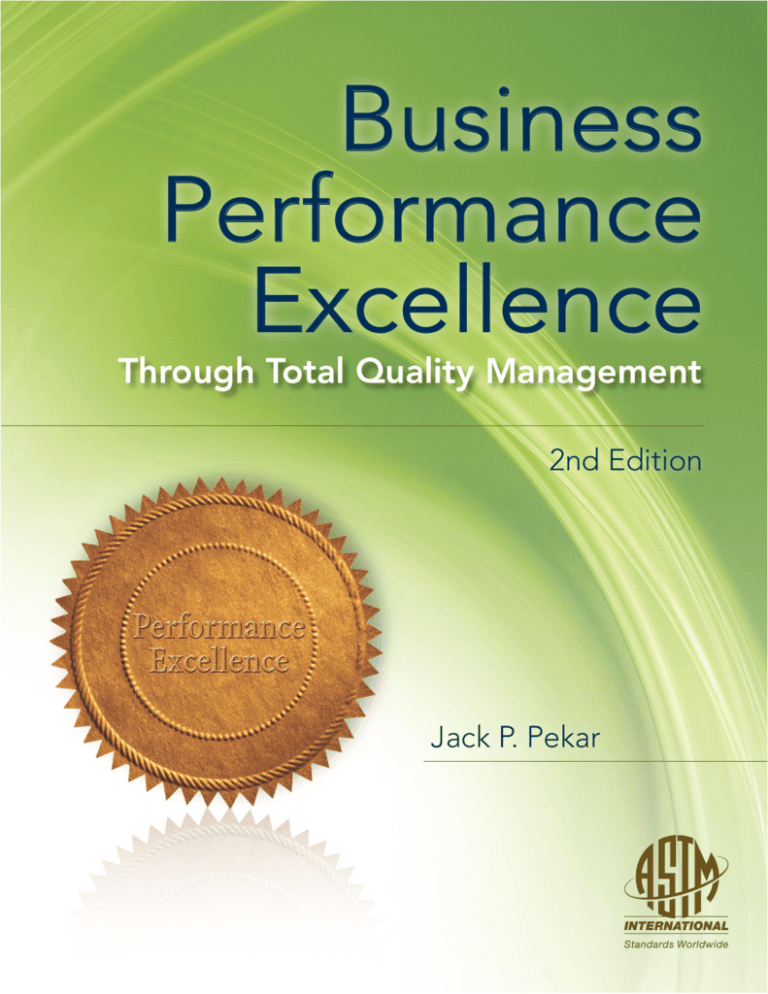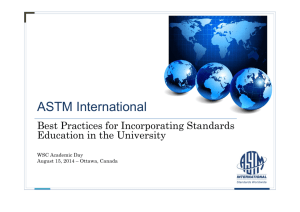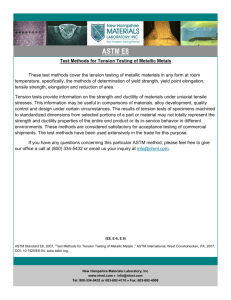
Business
Performance
Excellence
Through Total Quality Management
2nd Edition
Jack P. Pekar
Business Performance
Excellence through Total
Quality Management—
2nd Edition
Jack P. Pekar
ASTM Stock Number: MNL22-2nd
ASTM International
100 Barr Harbor Drive
PO Box C700
West Conshohocken, PA 19428–2959
Printed in the U.S.A.
Library of Congress Cataloging-in-Publication Data
Pekar, Jack P., 1940–
Business performance excellence through total quality management/Jack P. Pekar.
p. cm.
Rev. ed. of: Total quality management/Jack P. Pekar. 1995.
“ASTM stock number: MNL22-2nd.”
Includes index.
ISBN 978-0-8031-7005-6
1. Total quality management. I. Pekar, Jack P., 1940– Total quality management. II. Title.
HD62.15.P46 2009
658.4⬘013—dc22
2009020940
Copyright © 2009 ASTM International, West Conshohocken, PA. All rights reserved. This material may not be reproduced
or copied, in whole or in part, in any printed, mechanical, electronic, film, or other distribution and storage media, without the written consent of the publisher.
Photocopy Rights
Authorization to photocopy item for internal, personal, or educational classroom use, or the internal, personal, or
educational classroom use of specific clients, is granted by ASTM International provided that the appropriate fee
is paid to ASTM International, 100 Barr Harbor Drive, PO Box C700, West Conshohocken, PA 19428-2959; Tel:
610-832-9634; online: http://www.astm.org/copyright.
NOTE: The Society is not responsible, as a body, for the statements and opinions expressed in this publication. ASTM
International does not endorse any products represented in this publication.
Printed in Dayton, Ohio
November, 2009
Foreword
Committee F16 on Fasteners wants to do all it can to assure that the fastener industry is able to comply with the Fastener
Quality Assurance Act 共FQA兲 of 1990, which was last amended on June 8, 1999. F16 is comprised of fastener manufacturers,
users, and distributors, all of whom have a large stake in this law. As a consequence, F16 requested and sponsored me to write a
manual that would show our members how to comply with the law and remain competitive. But this book goes beyond assisting
those in the fastener industry to cope with the FQA. It can be of benefit to any industry or enterprise because it is about Performance Excellence through Total Quality Management 共PE/TQM兲. This revision puts more of a focus on criteria that shapes the
guidelines for performance excellence defined in the Baldrige National Quality Program.
This book was written so that others may share what I have learned through 43 years in the quality profession. It is a book
that presents principles and guidelines that, when applied, can be used to develop and implement a total quality management
system. Today, more than ever, we in the business community face challenges at every turn from every corner of the world.
Those businesses that survive will be those that demonstrate leadership innovation and apply a customer-centered and processdriven approach to their business practices.
Those who practice the teachings in this book have a better chance than most to achieve success. They may find the journey
difficult and cluttered with obstacles that impede their progress, but, if they are true leaders, their message will be heard. They
must not and cannot be discouraged for they must lead us to and through the new global market.
iii
Contents
Introduction
vii
Chapter 1—Management’s Role
1
Chapter 2—Strategic Planning
6
Chapter 3—Continuous Improvement
17
Chapter 4—Quality Systems
24
Chapter 5—Quality Reporting
29
Chapter 6—Supplier Partnerships and Control
33
Chapter 7—Statistical Quality Control Six-sigma, and Lean Manufacturing
37
Chapter 8—Quality Manual Guidelines for ISO 9001
45
Chapter 9—Compliance with Public Law 101-592
49
APPENDICES
Appendix A: Synopsis of ASTM Standards F1469, F1503, F2282, and F2688
51
Appendix B: Supplier Quality Systems Survey
52
Appendix C: Attribute Gauge Analysis Form
57
Subject Index
59
Introduction
Because there is no single path to achieving performance excellence within an organization, there are no hard and fast
rules to follow to become a world class company.1 This is because all organizations have their own cultures, people, and
technologies. What may work well for one company will not
necessarily work for another. The only constants are basic
criteria/guidelines for performance excellence, which, when
followed, lead to success. These criteria/guidelines are as follows.
Leadership Commitment
The leadership of an organization must be committed to continuous improvement. This commitment must be visible
throughout all layers of management. Management must
“walk the talk.” Only when management is committed to create a sustainable, high-performing organization with a business and customer focus will employees excel at what they
do. It takes time to change work cultures and work habits, but
with perseverance the message of enlightened management
will prevail. Employees want to do a good job; all they need
are the right tools and the right systems. These can be supplied only by management.
Customer and Market Focus
The organization must be customer-centered. Everyone in
the organization must understand that without a customercentered approach to business practices there would be no
purpose to their work, no repeat business, and no positive referrals. What must also be understood is that the external
customers are served by the internal customers 共employees兲.
There is, therefore, a need to focus on the requirements and
expectations of both internal and external customers. One of
the first steps management should take in this regard is to
conduct surveys of the external and internal customers. The
voice of the external customer will provide knowledge about
the needs and desires of current and future customers. Employees 共internal customers兲 should be apprised of the results
of external customer surveys so they understand the needs of
the market that they serve. A truly committed management
team will also allow employees to see the results of internal
surveys. This brings “the good, the bad, and the ugly” to the
table for discussion. The good can be improved upon. The
bad can lead to opportunities for improvement. The ugly
must be addressed through open, two-way communication
with cross-functional teams to find solutions. The voice of the
internal customer may best be accessed through two survey
tools provided by the Baldrige National Quality Program: Are
We Making Progress? and Are We Making Progress As Leaders?
Workforce Focus
The organization must assess the current skill level and
awareness of total quality principles of all employees. This as1
Portions of this Introduction were taken either in whole or in part from an
SME technical paper by the author entitled, “Continuous Improvement—
Managing Yesterday, Leading Today.” Reprinted with permission of the Society of Manufacturing Engineers, Copyright 1993, from the Cold Forming ’93
Conference.
sessment begins with top management and moves throughout the organization. Begin by training top management on
total quality and performance excellence. Once top management is trained and committed to these criteria/guidelines, it
will be easy to train those who follow. This training will pay
high dividends at every level in the organization. Through
training, be sure that all employees have the necessary skills
and technical knowledge to perform their jobs effectively.
Thus they may be counted on to be effective participants in
contributing to the total quality and over-all improvement
process. Information should be provided to employees describing external educational programs available to them
through various professional organizations and colleges. By
creating an awareness of these opportunities, the organization demonstrates its commitment to continuous improvement of employee skills.
Soon after the commencement of training, management
must provide opportunities for employees to apply what they
have learned. They need to test their skills. They will not and
should not be content with the way things are. Every aspect of
their job should be evaluated and measured against the new
paradigms. This will bring new challenges to their managers.
The managers, in turn, through their own training, will now
be equipped with the attitudes and analytical skills to consider their suggestions. They will no longer feel the threat of
losing control.
Measurement, Analysis, and Knowledge
Management
In order for management or employee improvement teams to
determine if they made process improvements, they need to
know where they were when they began. If we do not have
historical data to let us know, we must at least determine
where we are through a short-term study.
The first step is to define the organization’s critical performance indicators 共CPIs兲, which are defined as those measures that contribute to customer satisfaction. There are several tiers of indicators in any organization, and they can be
broken down as primary, secondary, and tertiary. Examples
of first-tier CPIs include On-Time Delivery, Customer Satisfaction Indicators, and Cost of Quality. Second-tier CPIs are
measures that contribute to the first-tier CPIs. Examples of
second-tier CPIs for On-Time Delivery may be quote turn
around, manufacturing lead time reduction, and supplier
performance. Third-tier CPIs are the employee involvement
action items. Examples of third-tier CPIs for manufacturing
lead time reduction could be 共1兲 set up reduction and 共2兲 scrap
and rework reduction. CPIs are discussed in detail in Chapter
2. In general, the organization needs to measure, analyze, review, and improve its performance through the use of data
and information at all levels and parts of the organization.
Strategic Planning
It is the responsibility of senior management to understand
the organization’s competitive environment, their key strategic challenges and advantages, and their system for performance improvement. Senior management along with their
management team need to focus on actions that include onvii
viii
BUSINESS PERFORMANCE EXCELLENCE - 2ND EDITION
going improvements in productivity that may be achieved
through eliminating waste, improving customer satisfaction,
maximizing return on investment, and improving quality
through a strategic action plan. This plan should include Sixsigma and lean manufacturing principles, or variations of
these principles. One tool for this assessment is the Organization Profile analysis available through the Baldrige National
Quality Program. This document is free and can be obtained
from NIST.
The completion of this assessment sets the context for
the way your organization operates. It will clearly define your
environment, key working relationships, strategic challenges
and advantages, and provide you direction in guiding your
performance management system.
Process Management
The organization needs to understand its business processes,
and then design, manage, and improve them to deliver customer value and consistent organizational success and sustainability. One of the more useful tools to assess your business and its current state is to conduct an analysis of your
organization. The Organizational Profile work sheet serves
very well in providing you with the current state of your business. Once an understanding of the organization’s business
processes are known, they may be managed and improved
upon through such documents as ASTM F2688-082 共Standard Guide for System-Based, Customer-Centered Quality
Plan for Manufacturers兲, ISO/TS 16943 共Quality Management Systems—particular requirements for the application
of ISO 9001:2000 for automotive production and relevant service part organizations兲, ISO 90014 共Quality Management
Systems Requirements兲, and ASQ 9001 共Quality Management Systems兲. The application of statistical process control
共SPC兲, Six-sigma, and lean manufacturing in the organization’s processes will facilitate the effective elimination of
waste and create processes that are truly efficient.
Recognition and Awards
Everyone appreciates a pat on the back after they have
achieved a noteworthy goal or successfully completed a difficult or important task. This encourages further participation
2
3
4
Annual Book of ASTM Standards, Vol 01.08.
Available from Automotive Industry Action Group 共AIAG兲, 26200 Lahser Rd.,
Ste. 2000, Southfield, MI 48034-9738.
Available from the American National Standards Institute, 11 W. 42nd St.,
13th Floor, New York, NY 10036.
䊏
by the employee and shows other employees that their efforts
are appreciated. When a team has met an established goal,
the entire team should be recognized.
The form of recognition should fit the accomplishment;
in other words, the value of the recognition should be commensurate with the value of the accomplishment. Also, when
recognition is given, it should be consistent. To assure consistency, a panel of management and nonmanagement employees should be established to set up a recognition program to
acknowledge those individuals and/or teams who meet company objectives.
Communication
The organization must communicate with the work force,
their suppliers, and their customers. I cannot provide enough
differentiation among this trilogy to say one is more important than the other. All participants in this trilogy of communication must interface for an organization to be truly successful. Within the organization, employees at all levels need
information about continuous improvement projects so they
can become aware of progress, their contribution, and the effect these projects have on critical performance indicators.
Business goals must be communicated to suppliers. Suppliers should be viewed as extensions of the organization who
contribute to the overall success of continuous improvement.
They should be part of decisions to utilize purchased services.
Suppliers are specialists in their fields of expertise; therefore, their input should be required when decisions are made
to use them. World class purchasers understand the difference between price and value. As purchasers 共customers兲 we
expect, and should demand, products that contribute to our
success. The voice of the customer must be heard. Customers
are the reason we are in business. Without customers, no provider of goods or services could survive. To understand customers’ needs, we must listen to their messages. Invite existing and potential customers to your facilities and ask them to
apprise your management team of their business objectives.
Ask how you can assist them in achieving their goals.
Results
An organization must make it a point to examine the effectiveness of performance and improvement in all eight of the
previously mentioned criteria on the path to Performance
Excellence: Leadership Commitment, Customer and Market
Focus, Workforce Focus, Measurement, Analysis, and
Knowledge Management, Strategic Planning, Process Management, Recognition and Rewards, and Communication.
Acronyms
ANSI
ASQ
ASTM
BNQP
CMM
CPI
DMADV
DMAIC
E&I
FAC
FMEA
FQA
HRC
JIT
LPA
NIST
NVLAP
P&IC
PE
PE/TQM
PIE
QFD
R&R
SCD value
SEM
SME
SPC
SPQP
SQC
TCQ
TQM
American National Standards Institute
American Society of Quality
American Society for Testing and Materials
Baldrige National Quality Program
Coordinate Measuring Machine
Critical Performance Indicators
Define, measure, analyze, design, verify 共used in Six-sigma applications兲
Define, measure, analyze, improve, control 共used in Six-sigma applications兲
Empowerment and Involvement
Fastener Advisory Committee
Failure Mode and Effects Analysis
Fastener Quality Act
Hardness Rockwell C
Just in Time
Layered Process Audits
National Institute of Standards and Technology
National Voluntary Laboratory Accreditation Program
Production and Inventory Control
Performance Excellence
Performance Excellence/Total Quality Management
Plan, Initiate, Evaluate
Quality Function Deployment
Repeatability and Reproducibility
Severity rank times the Capability rank times the Detection rank
Scanning Electron Microscope
Society of Manufacturing Engineers
Statistical Process Control
Service/Product Quality Planning
Statistical Quality Control
Total Cost of Quality
Total Quality Management
ix
About the Author
Jack P. Pekar is a graduate of the Ohio University with a Bachelor of Science in Education,
majoring in mathematics. He is the lead principal for PT&G Consulting, specializing in the
Baldrige National Quality Program’s Criteria for Performance Excellence.
Jack has been active in the fastener and quality profession since 1964. His experience includes
that of line inspector, supervisor, manager, and owner as he gained knowledge in his chosen
profession. He worked for such fastener manufacturers as Lamson & Sessions, E.W. Ferry Screw
Products, and SPS Technologies. At these organizations, he gained valuable experience in all
phases of fastener processing. At Cleveland Twist Drill, Allied Machine & Engineering, and
Kennametal Inc., he gained knowledge as a fastener purchaser and user. At these organizations,
he set up programs to assure strong and viable supplier bases. He led all of these companies to
many successful certification awards from major corporations as well as ISO 9000 registration.
Jack has been a member of ASTM International (ASTM) since 1976 and served as subcommittee
chairman for F16.93, Quality Assurance Provisions for Fasteners,
Vice Chairman of F16.01, Test Methods, and Main Committee
Chairman of F16 on Fasteners. He is a Fellow of ASTM, and
a senior member of SME and ASQ. He served on the Board
of Directors of the American Association for Laboratory
Accreditation (A2LA), and ASTM. Jack also served on the Board
of Examiners for the Baldrige National Quality Program during
2002, 2003, and 2004.
In addition to his business activities, he was active civically
and served on the Board of Directors and as Vice President of
the Solon Chamber of Commerce. In 1991, Mr. Pekar received
the President’s Award from that organization for outstanding
community service.
www.astm.org
ISBN 978-0-8031-7005-6
Stock #: MNL22-2ND



